|
|
|
|||
|
|
||||
|
|
||||
| The (Jet)X Files | ||||
|
|
HOME | SITE MAP | FORUM | CONTACT |
|
||
|
ABOUT | MOTORS | MODELS | ARCHIVE | HISTORY | STORE | FAQ | LINKS
|
|
|
|
|
|
|||||||||||||||||||||||||||||||||||||||||||||||||||||||||||||||||||||
|
The (Jet)X Files 7
(July 2003)
by Roger Simmonds Reprinted from SAM 35 Speaks, July 2003 I have continued to explore our pre-Jetex roots, and this month’s vintage plan is for P A Latham’s ‘Glirt’ (right), which was published in the November 1946 Aeromodeller. The twin boom layout of the |
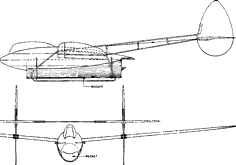
- Aeromodeller, Nov. 1946
|
|||||||||||||||||||||||||||||||||||||||||||||||||||||||||||||||||||||
|
One of the original Jetex websites, set up by the legendary Dr Edward Jones, contained much material from the ‘golden days’ of Jetex. It has now been fully restored with all the original articles plans, etc., in a new home at Jetex.org. This has been set up by Ben Nead and will eventually cover all aspects of rocket (jet) propelled models, including Rapiers I would encourage readers to visit Jetex.org and contribute. There is a very nice historical archive, and Ben is looking for articles, plans, advertisements, photos of models and motors, etc., related to Jetex and other means of rocket propulsion. These can be sent to to John Miller Crawford in New Zealand, or to me, if this is more convenient (the addresses are on the website). Photocopies are fine, though these should preferably be colour photocopies, even if the originals are black and white, as this makes for a much more faithful reproduction. If you have a scanner then all sorts of electronic files can of course be sent direct, and I am also happy to scan material for people. |
 |
|||||||||||||||||||||||||||||||||||||||||||||||||||||||||||||||||||||
|
|
|
|||||||||||||||||||||||||||||||||||||||||||||||||||||||||||||||||||||||||
|
The data on the Wilmot Mansour (and later Sebel) ‘Tailored’ designs is particularly pleasing to me, as I hope to recreate some of these models. This presents two major challenges; producing a moulded fuselage from thin balsa to match the original, and powering the model with a modern motor. I hope to discuss moulded fuselages in a future column, but the motor situation is of more concern at the moment. It is possible to find Jetmasters, PAA-Loaders, 50Bs and propellant, but these have become collector’s items and can be very expensive. There are plans to produce a reliable fuel and recreate the motors, but until these replicas are available, Rapier power is the best option for those who, like me, are without large reserves of Jetex motors and pellets. There is as yet no Rapier equivalent to the Jetmaster, but the L-2 and L-2HP should be suitable for the smaller (‘Mach 1’) models. It is not too difficult to make an augmenter tube to match these units, though an efficient design would differ from the Jetex 50 augmenter tube in a number of ways. |

- Roger Simmonds
|
|||||||||||||||||||||||||||||||||||||||||||||||||||||||||||||||||||||||||
|
This notwithstanding, Tony Betts has built the Darnell-designed Folland Midge for Rapier power around a homemade aluminium foil augmenter tube of traditional design (right). Tony replaced the ‘Bristol board’ covering with thick cartridge paper (on which he photocopied the templates), but apart from this he has followed the Aeromodeller plan exactly, and the Whilst I was dubious about the all-sheet balsa wing and weight of the original design, the compatibility of a high power Rapier |

- Tony Betts
|
|||||||||||||||||||||||||||||||||||||||||||||||||||||||||||||||||||||||||
|
The Leduc 021 was an extraordinary air launched French equivalent to the Bell X-1 powered by a massive ramjet (or tuyère thermopropulsive) of innovative design. It was described in Aeromodeller ‘Aeroplanes in outline No. 47’ (published as J.156), and this quirky design seemed in my naïveté to be a good choice of prototype, as a wing span of 11" equated to an ‘augmenter’ tube of 1.25" diameter some 8" long. The main body is built around this tube, and the motor is mounted in the main pod (right), exhausting into a tapered cone. The photos show construction details, which are unremarkable. The model is of a similar shape and size to the Aerographics Bell XS-1 or Miles M.52, though the fuselage is tubbier and moment arm shorter than either, which are not good stability features. The wings are even more diminutive and glued to balsa blocks in the fuselage as the preferable ‘straight through’ option was not available. The tail surfaces are also quite small, even though enlarged by 30%, and are built up with moveable surfaces. I was quite pleased with the model, though with some reservations, for example the weight, which will be discussed later. Trimming began quite well, as test glides were fast and straight, so an |
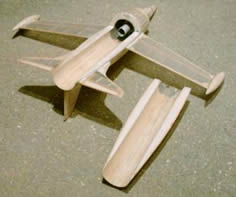
- Roger Simmonds
|
|||||||||||||||||||||||||||||||||||||||||||||||||||||||||||||||||||||||||
|
This was becoming frustrating as every ‘landing’ required repairs to stress fractures to the wing. So I fitted an At this point, a time for quiet reflection was thought expedient. I suppose I shouldn’t have been too disappointed, as this model was after all only meant to be a ‘proof of concept’ that Rapiers could be enclosed. In retrospect, I should have adapted an established design (like a MiG 15) for this experiment, but I was attracted to an unusual design that had not been modelled before. In the course of drawing it up and building, I rather lost sight of my original concept, however, and placed too great an emphasis on scale fidelity with a design that would obviously be of marginal stability anyway. Reflections on the model include: |
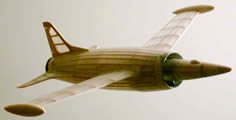
- Roger Simmonds
|
|||||||||||||||||||||||||||||||||||||||||||||||||||||||||||||||||||||||||
|
1. It is too heavy at 44 g. As a rule of thumb, a weight of about four times the available thrust is thought feasible, and Mike Stuart has a 44g Bell XS-1 (right) that flies well with an 3. The wing tip pods are carved from light balsa and rigidly attached. This meant that in anything other than a straight arrival the pod dug in and twisted the wing, which either came off completely or needed extensive tissue repairs. Wing tip pods are bad news and if they have to be there they should be light and flexible, and come off in a hard arrival. 4. The enclosed motor seems to be producing less than its nominal thrust. The large diameter augmenter tube was supposed to minimise interference to the motor. It had not been optimised for augmentation, as this would entail a complex double taper, but I did not expect thrust to be retarded. It may be that the intake area is too large and the taper is too shallow, or the rear of the nose pod may be creating turbulence around the motor nozzle, exactly where it isn’t needed. |
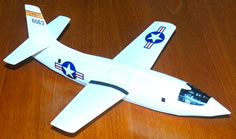
- Mike Stuart
|
|||||||||||||||||||||||||||||||||||||||||||||||||||||||||||||||||||||||||
|
5. (Lastly!) there could be more skin drag associated with the tube than I anticipated.
All in all the ‘Mk 1’ Leduc seems to be something of a ‘Le turkey’ (sorry!) with features reminiscent of the Tailored Starfighter (right) I was so dubious about in a previous column. Its cardinal fault is that its weight and flying speed precluded sensible trimming. A variety of repairs was required after each flight, so that no consistent flight pattern could be established and refined. Still, I have learned a lot, and the most useful result is that the aluminium foil was not scorched or damaged, even by the In my discussion of the viability of designs in May’s column, I had ignored the effect of weight, though it is a received truth that if you want a small scale model to fly at all, then add lightness. I had little idea of the actual wing loadings of the classic Flying Scale and other designs, so I did a little research. The results of a quick survey of some past and present designs for Jetex 50 or Rapier |

- Roger Simmonds
|
|||||||||||||||||||||||||||||||||||||||||||||||||||||||||||||||||||||||||
Again, I apologise for the mixed units. I realise there are better ways of expressing wing loadings, but most people are used to ‘oz/sq. ft’. Quoted weights are approximate for models with ‘empty’ motors. The Keilkraft Flying Scale designs (right) and the Aerographics Flitzer come out at about 5-6 oz/sq. ft. Modern designs such as the Miles M.52 have higher loadings, but the Leduc 021 and the Starfighter take the prize, with the Midge not far behind. Now a low wing loading implies that the lowest possible power (I love Richard Crossley’s phrase, ‘whiff of power’) can be used and airspeed kept to a minimum. This ameliorates stresses on the airframe and keeps models docile. |
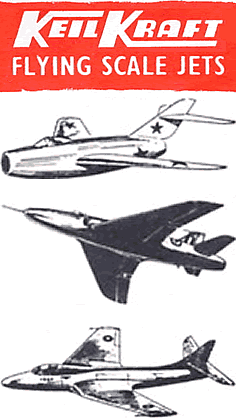
- Keilkraft catalogue c. 1960
|
|||||||||||||||||||||||||||||||||||||||||||||||||||||||||||||||||||||||||
|
However, this may not be quite the whole story with respect to small jet planes and whether they will fly well, or indeed at all. I have now finished a second Leduc 021 (right) with many detail modifications such as reduced dihedral, lighter and more fragile wing tip pods, and reduced stringers. The augmenter tube is a balsa/foil sandwich, which weighs only 4.5 g. The motor is further forward so that the nozzle is just in front of the CG, and the air intake has been changed to a convex bell, which I hope will prove more efficient. The ‘Mk 2’ weighs about 32 g (12 g lighter than the first), giving a wing loading of 8.7 oz/sq. ft, still high, but, according to the table, not too outrageous. |
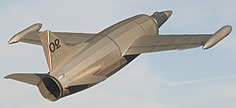
- Roger Simmonds |
|||||||||||||||||||||||||||||||||||||||||||||||||||||||||||||||||||||||||
|
All of the above was written before I attended a meeting at Old Warden on May 24/25. Considering the weather (gusty with the occasional downpour) there was a good turnout of rocket fliers and we had fun despite the wind, which tended to drop only when a thermal was overhead. This caught out several fliers, including Pete Smart, whose very nice Douglas Skyrocket caught a thermal (oh wow!) and drifted over the road into the model eating bean field. During the day this leguminous equivalent to Charlie Brown’s ‘kite-eating tree’ consumed Andy Blackwell’s BAC 221 (right), a Flitzer, Mike Stuart’s Rapier powered KK Cub, and Chris Strachan’s Doodlebug. It very nearly had Derek Knight’s beautiful ducted fan MiG 15 for an evening snack. Some designs coped with the conditions better than others. The Skyrocket, Bell XS-1, the Lightning and my MiG 15 all went well. In contrast, a Komet and my FD 2 did not like the turbulence coming off the trees at all, and Pete Smart’s L1 powered Seahawk really needed calmer conditions to fly well. |
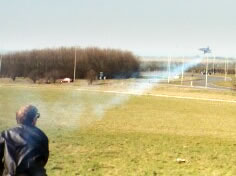
- Andy Blackwell
|
|||||||||||||||||||||||||||||||||||||||||||||||||||||||||||||||||||||||||
|
Tony Betts’ twin L2 powered SARO A/1 (built without the pendulum rudder) also gave the impression it would fly OK on a more suitable day. Fortunately, he had also brought the Folland Midge (right). This was a real thrill for me, and I had a good look at it. The augmenter tube was blackened, but appeared to be surviving well, and the |
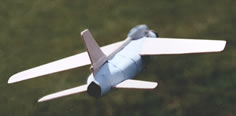
- Tony Betts
|
|||||||||||||||||||||||||||||||||||||||||||||||||||||||||||||||||||||||||
|
My Leduc 021 Mk 2 (right) had its maiden powered flight. It climbed away from a gentle launch and nearly completed a wide circle before it lifted a wing and side slipped to the ground, fortunately without damage. This was very encouraging and made up for the earlier frustrations of the day. The design has stimulated some interest – I may now have to draw up a proper plan! |

- Roger Simmonds
|
|||||||||||||||||||||||||||||||||||||||||||||||||||||||||||||||||||||||||
|
The splendid flights of Andy Young’s Bell XS-1 and Tony’s Midge led me to reflect further on wing loadings and model performance. The Aerographics Lightning (right) apparently needs a good chuck and a very high rated L2-HP to get away in the difficult conditions, but Andy’s much repaired model, though rather heavy at 46 g, appeared to be more than adequately propelled by a 105 mN |
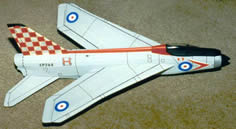
- Chris Starleaf
|
|||||||||||||||||||||||||||||||||||||||||||||||||||||||||||||||||||||||||
|
|
||||||||||||||||||||||||||||||||||||||||||||||||||||||||||||||||||||||||||
|
|
|
|||||||||||||||||||||||||||||||||||||||||||||||||||||||||||||||||||||||||
|
|
|
|
|
|
|
|
Acknowledgements - Article: Roger Simmonds - Illustrations: Brian Benson, Andy Blackwell, Tony Betts, MAAC archives via Bill Henderson, Roger Simmonds, Chris Starleaf, Mike Stuart |
|
|
|
|
ABOUT | MOTORS | MODELS | ARCHIVE | HISTORY | STORE | FAQ | LINKS |
|
|
Terms of Use
|
Queries? Corrections? Additions?
Please
contact us.
|
|